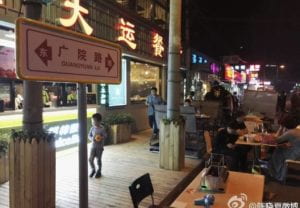This week, we read about several discussions around street food, pushcarts and vendors. Bluestone articulates the different developmental stages of pushcarts in New York City, whereas Ray focuses more on how vending reflects the level of social justice and society’s plurality. It is always accepted that street food provides liveness to urban space, but few people look deep into how such liveness is created. In this post, I would like to share some of my thoughts about why street vending and pushcarts could vitalize the city.
One factor that could account for such a phenomenon is that consumers could witness how their dishes are made when buying food on the street. I had my undergraduate study at the Communication University of China, and there is a street full of street peddlers near the west door of the university. One thing I enjoyed most during my undergraduate study was watching those vendors cooking their food. Unlike in the restaurant, where the whole cooking process is hidden in the kitchen, vendors have no choice but show how they cook the food. Some vendors may even make cooking as a performance to show how professional they are and attract passersby. The cooking process’s transparency is essential for street food because the vendors have to promote their food by using appetitive sources and a strong smell. The word “Liveness” in China is called “烟火气”, with a direct translation of “the smoke produced by cooking.” This word shows that traditional Chinese regard the cooking smoke as a symbol of cozy daily lives. Cooking smoke is never a pleasant thing to most people, but it indicates such a beautiful and vivid view of life in a traditional Chinese cultural context. Perhaps food is meant to be created in a messy and informal environment in the Chinese cultural gene.

(The street full of pushcarts near my university)
Another reason whystreet food could contribute to urban space’s livingness recalls the memory from our childhood. When I was a high school student, I had only little pocket money every month and couldn’t afford to dine out in a restaurant. But street food is much cheaper than the dishes served in the restaurant and always target student as their most important consumers. There were always pushcarts with all kinds of street food near the school gate, and I just couldn’t help to buy some of them on my way home. Thus, street food for me carries a nostalgic meaning. Even now, when I pass some pushcarts, the first idea floats into my mind would be, “I’ve seen that (or I’ve had that) in my high school period.”
It is exactly because I am witnessing how vendors put their labors in cooking and those memories around food from my childhood that make me feel empathetic for the vendors. For the last few years, the Beijing government issued policies against pushcarts food and informal food stores in the city. I understand such actions are meant to clean up the city, but I didn’t enjoy its result. Beijing indeed became neater, but it lost so much vigor in this process. I agree with Ray’s point that a city should be a public space that allows people from all social classes to earn a living. Sometimes an organized city is built upon the exclusion of certain groups of people and the elimination of the collective memories of previous generations.
Leave a Reply